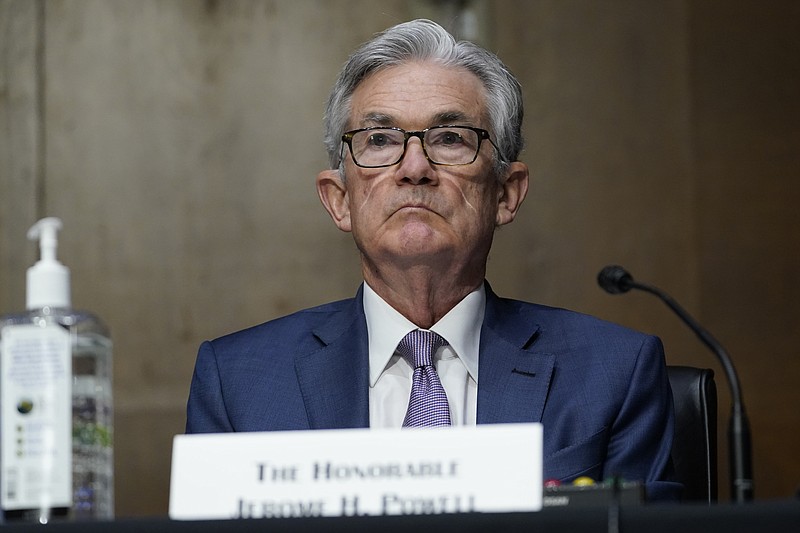WASHINGTON -- The Federal Reserve signaled Wednesday that it may act sooner than previously planned to start dialing back the low-interest-rate policies that have helped fuel a swift rebound from the pandemic recession but have also coincided with rising inflation.
The Fed's policymakers forecast that they would raise their benchmark short-term rate -- which affects many consumer and business rates, from mortgages to auto loans -- twice by late 2023. They had previously estimated that no rate change would occur before 2024.
But at a news conference after its latest policy meeting, Chairman Jerome Powell sought to dispel any concerns that the Fed might be in a hurry to withdraw its economic support by making borrowing more expensive. The economy, Powell said, still hasn't improved enough for the Fed to reduce the pace of its monthly purchases of treasury and mortgage bonds. Those purchases have been intended to hold down long-term loan rates to encourage borrowing.
The Fed has said it will keep buying $120 billion a month in bonds until "substantial further progress" has been made toward its goals of maximum employment and inflation sustainably above 2%.
"We are a ways away from substantial further progress, we think," Powell said Wednesday. "But we are making progress."
[Video not showing up above? Click here to watch » https://www.youtube.com/watch?v=OeqYfXdhmt8]
For the same reason, the chairman said, it's too early for Fed officials to discuss when they might raise their benchmark short-term rate from its record low near zero. But he did note that many of the policymakers think the central bank's goals "will be met somewhat sooner than previously projected."
In his remarks, Powell drew a mostly positive picture of the economy. The inflation spikes of the past two months, he said, likely will prove temporary, and hiring should accelerate through summer and into the fall as covid-19 recedes further with increasing vaccinations, the reopening of schools and day care centers reopen -- which will allow more parents to work -- and the ending of supplemental federal aid for the unemployed.
"There is every reason," Powell said, "to think that we will be in a labor market with very attractive numbers, with low unemployment, high participation and rising wages across the spectrum."
In its statement after the policy meeting ended, the Fed said it expects the pandemic to have a diminishing effect on the economy as vaccinations increase, thereby allowing for more growth.
"Progress on vaccinations has reduced the spread of covid-19 in the United States," it said. "Amid this progress and strong policy support, indicators of economic activity and employment have strengthened."
The central bank raised its forecast for inflation to 3.4% by the end of this year, from 2.4% in its previous projection in March. Yet the officials foresee price increases remaining tame in the next two years.
Fed officials expect the economy to grow 7% this year, which would be the fastest calendar-year expansion since 1984. They project that growth will slow after that, to 3.3% in 2022 and 2.4% in 2023.
The Fed is grappling with a dilemma: Inflation is rising much faster than it had projected earlier this year. And America's increasingly vaccinated consumers are now comfortable venturing away from home to travel, to go to restaurants and movie theaters and to attend sporting events. Solid consumer spending is accelerating economic growth, and manufacturing and housing have significantly strengthened.
Yet hiring hasn't picked up as much as expected. Monthly job growth has remained below the 1 million-a-month level that Powell had said in April he would like to see, though employers are clearly interested in hiring more, having posted a record number of available jobs.
Economists generally expect the Fed to continue discussing tapering its bond purchases and then -- by late August or September -- to outline specifically how and when it would begin. That would set the stage for a reduction in bond purchases to actually begin near the end of this year or in early 2022.
Last week, the government reported that inflation jumped to 5% in May compared with a year earlier -- the largest 12-month spike since 2008. The increase was driven partly by a huge rise in used car prices, which have soared as shortages of semiconductors have slowed vehicle production. Sharply higher prices for car rentals, airline tickets and hotel rooms were also major factors, reflecting pent-up demand as consumers shift away from the large goods purchases many of them had made while stuck at home to spending on services.
Prices for such services, which had tumbled, are now regaining pre-pandemic levels. With more people gradually returning to work in person, the reopening of the economy has also forced up prices for clothing. Yet such price increases may not last.
Another key consideration for the Fed is whether inflation persists long enough to affect the public's behavior. If Americans begin to expect price increases, those expectations can trigger a self-fulfilling cycle as workers demand higher wages, which, in turn, can lead their employers to keep raising prices to offset their higher labor costs.
So far, bond yields and consumer surveys suggest that while higher inflation is expected in the short term, investors and most of the public expect only modest price gains in the long run. Powell has long maintained that the public's perceptions of future inflation evolve only slowly.
